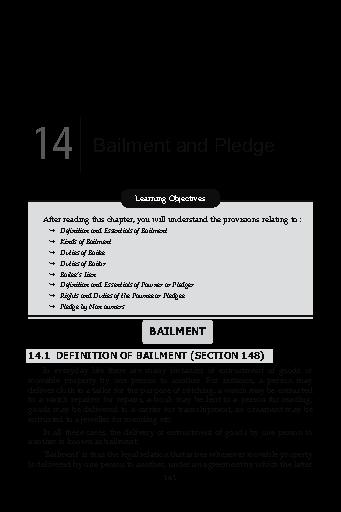© Bhushan Kumar Goyal
Printing and publishing rights with the publisher
Thirteenth Edition : June 2025
Price : ` 1045 (For a set of two volumes)
Published by :
Taxmann Publications (P.) Ltd.
Sales & Marketing :
59/32, New Rohtak Road, New Delhi-110 005 India
Phone : +91-11-45562222
Website : www.taxmann.com
E-mail : sales@taxmann.com
Regd. Office :
21/35, West Punjabi Bagh, New Delhi-110 026 India
Printed at :
Tan Prints (India) Pvt. Ltd.
44 Km. Mile Stone, National Highway, Rohtak Road Village Rohad, Distt. Jhajjar (Haryana) India
E-mail : sales@tanprints.com
Disclaimer
Every effort has been made to avoid errors or omissions in this publication. In spite of this, errors may creep in. Any mistake, error or discrepancy noted may be brought to our notice which shall be taken care of in the next edition. It is notified that neither the publisher nor the author or seller will be responsible for any damage or loss of action to any one, of any kind, in any manner, therefrom. No part of this book may be reproduced or copied in any form or by any means [graphic, electronic or mechanical, including photocopying, recording, taping, or information retrieval systems] or reproduced on any disc, tape, perforated media or other information storage device, etc., without the written permission of the publishers. Breach of this condition is liable for legal action.
For binding mistake, misprints or for missing pages, etc., the publisher’s liability is limited to replacement within seven days of purchase by similar edition. All expenses in this connection are to be borne by the purchaser. All disputes are subject to Delhi jurisdiction only.
Preface to Thirteenth Edition
Acknowledgement
Syllabus
CHAPTER 1
ACCOUNTING SYSTEM
CHAPTER 2
CAPITAL AND REVENUE EXPENDITURES AND RECEIPTS
CHAPTER 3
EVENTS OCCURRING AFTER THE BALANCE SHEET DATE
CHAPTER 4
EXTRAORDINARY ITEMS, PRIOR PERIOD ITEMS, ACCOUNTING
ESTIMATE, ACCOUNTING POLICIES AND FAIR VALUE
CHAPTER 5
PROVISIONS, CONTINGENT LIABILITIES AND CONTINGENT ASSETS
CHAPTER 6
FINANCIAL ACCOUNTING PRINCIPLES
CHAPTER 7
INTRODUCTION TO ACCOUNTING STANDARDS AND IND AS
CHAPTER 8
ACCOUNTING PROCESS : JOURNAL AND LEDGER
CHAPTER 9
ACCOUNTING PROCESS : SUBSIDIARY BOOKS, LEDGER AND TRIAL BALANCE
CHAPTER 10
ACCOUNTING FOR GOODS AND SERVICES TAX
I-12 CONTENTS
CHAPTER 11
MEASUREMENT OF BUSINESS INCOME AND REVENUE RECOGNITION
CHAPTER 12
ACCOUNTING FOR PROPERTY, PLANT, EQUIPMENT AND DEPRECIATION
CHAPTER 13
ACCOUNTING FOR INTANGIBLE ASSETS
CHAPTER 14
INVENTORY VALUATION
CHAPTER 15
CHAPTER 16
CHAPTER 17
ACCOUNTING FOR INLAND BRANCHES
CHAPTER 18
DEPARTMENTAL ACCOUNTING
CHAPTER 19
LEASE ACCOUNTING
CHAPTER 20
COMPUTERIZED ACCOUNTING SYSTEM
COMPUTERIZED ACCOUNTING SYSTEM
Learning Objectives
After studying this chapter, the learners will be able to understand:
Manual v. Computerised Accounting
Advantages of the Computerised Accounting System
Limitations of Computerised Accounting System
Grouping of Accounts
Format for Profit and Loss Account
Format of Balance Sheet
Codification
Points to be considered while selecting a Computerised Accounting Software
Package
Tally : An Accounting Software
Working with Tally-Prime
Preparation of Final Accounts in Tally
Company Creation
Group Creation
Ledger Creation
Voucher Entry
Types of Vouchers
Displaying Profit and Loss Account, Balance Sheet and Trial Balance
Displaying Other Reports
GST Configuration
Backup and Restoring Data of a Company
Accounting is a necessary function for all the business concerns be it a trading concern, manufacturing concern or a service provider. It is the method in which financial information is gathered, processed and summarized into financial statements and reports that provides information for decision making. The process of accounting can be explained with the help of the following diagram :
Process of Accounting
With the increasing number of transactions (for the business concerns), the manual method of keeping and maintaining records has become unmanageable. That is why, firms are replacing manual method of accounting by computerized accounting. Now, with the help of computers and accounting software, the accountants just need to do the voucher entry. The computer takes care of posting these entries to the respective ledgers and prepares Trial Balance, Profit and Loss Account, Balance Sheets, and calculates major financial ratios with a great speed and accuracy. The accounting programs carry out functions such as invoicing, dealing with payments, paying wages and provides regular accounting reports such as Trading and Profit and Loss account, Balance Sheets, etc. They provide instant reports like Stock valuation, Sales analysis, VAT returns, Budget analysis, etc. to the managers for decision making.
If we take it as an information system, it is one of the transaction processing systems that is concerned with financial transactions of a business enterprise only. It is concerned with data entry, data validation (ensuring accuracy and reliability of data), processing and revalidation (ensuring valid data has been fed to the system), storage, information generation and reporting it to the people concerned. It is a computer based information system as it uses both human resources and computer resources for generation of the information.
MANUAL v. COMPUTERISED ACCOUNTING
The manual accounting system starts with book keeping. We prepare journal book, sales book, purchase book, cash book, etc. Then we open accounts with their opening balances (if any).
We pass journal entries for the transactions that take place during an accounting year and then these journal entries are posted in their respective ledgers. To check the accuracy of the accounts a trial balance is prepared. Then we pass adjustment entries and prepare Trading and Profit and Loss Account and a Balance sheet. To analyse the performance, we calculate various financial ratios. All the steps explained above are performed by the human beings and hence, it is prone to errors.
In computerized accounting system, the entire lengthy process of a manual accounting is reduced to the following four steps :
1. Creation of a Company: At this step, the basic information about the company is fed in the software and the configuration is set as per the business process of the company (it is explained with the help of Tally later).
2. Creations of Groups: At this step, various groups are created for the accounts and the inventories. In accounting software packages generally the groups are defined but they also allow creation of new groups (if required).
3. Ledger creation: After the groups are defined we need to create various ledgers in different groups. For example individual ledger accounts of different debtors are created under the group ‘debtors’.
The above explained three steps are required for the first time only. Unless a new group or a new ledger is required the accountants continue working with these groups and ledgers.
4. Voucher Entry: Voucher entry is the last step in the computerized accounting system. The computerized ledgers are fully integrated. When a business transaction is inputted on the computer through various vouchers, it is recorded in all the respective ledgers automatically.
After the voucher entry is done all other functions like summarizing the ledgers, preparation of trial balance, profit and loss account and balance sheet is done by the computer on its own after every transaction.
The difference between the manual accounting system and computerized accounting system is explained below with the help of the following table :
Table 18.1 : Difference between manual accounting and computerized accounting system.
Basis
Recording The nancial transactions are recorded through the books of original entry
Classi cation The transactions recorded in the books of original entry are posted into respective ledger accounts.
Summarizing The ledgers are summarized (and their balances are ascertained) to prepare the trial balance
Adjustment entries To Adhere to the matching concept, the adjusting entries are passed.
The nancial transactions are stored in well-designed database.
The ledger accounts are produced, after processing the transactions stored in the database, in the form of a report.
The computer does not generate ledger accounts to prepare trial balance. It automatically generates trial balance as a report.
In computerized accounting system, there is nothing like adjustment entries for errors and recti cation.
20.4
COMPUTERIZED ACCOUNTING SYSTEM
Basis Manual Accounting System Computerized Accounting System
Trial Balance for Financial Statements
The trial balance is required for the preparation of nancial statements.
The nancial statements are prepared by the computer independent of availability of trial balance.
In nutshell, we can say that in computerized accounting system, voucher entry is the end of the accounting process.
ADVANTAGES OF THE COMPUTERIZED ACCOUNTING SYSTEM
The computerized accounting system offers various advantages to the business organizations in handling a large number of transactions that a modern business organization is expected to deal with. There are three major advantages that a computerized accounting system offers speed, accuracy and instant reports.
1. Speed: When manual accounting system is adopted each and every transaction which is passed in the books of account is required to be posted in the respective ledger accounts manually by the accountant. With volumes of transactions, their process requires a good amount of time and accounting staff.
But, with a computerized accounting system as the voucher entry is completed the accounting process is over and the software takes care of other functions that reduces time and staff requirement.
2. Accuracy: In manual accounting system, the recording, classifying, and summarizing functions are performed manually by the human beings which is error prone. But in case of computerized accounting system there is lesser or negligible room for errors as only one entry has to be passed and other functions are automatically performed by the computer system.
3. Instant Reports: As compared to manual system, it is easier to produce the end of the period reports like profit and loss account, balance sheet, etc. As soon as an entry is passed, the software reflects its impact in profit and loss account and in the balance sheet. Therefore, after every transaction the reports can be generated and printed with click of a mouse.
There are several other advantages also of using computerized accounting system.
4. Reduced Paperwork: By adopting computerized accounting system, the transactions are stored on hard disk unlike manual accounting system in which volumes of accounting records in paper form are kept that requires huge storage space. Also the retrieval of transaction details are easier in computerized accounting system than manual accounting system.
5. Up-to-date Information: The accounting records are automatically updated and therefore, the various ledger balances like customer’s accounts, etc. remain up to date. The balances can be known just with a click of mouse within seconds.
6. Lower Cost: The cost of maintaining books of account under computerized accounting system is very low as compared to the cost of processing and storing accounting data in manual accounting system.
7. Management Information: The managers can have accounting information as and when required to monitor and control the business activities. For example, they can have information about the debtors whose balances are overdue and can take some decisions to recover the amount (may be by offering some more discount, etc.)
8. Scalability: The computerized accounting system easily adopts to the present and future needs of the business enterprise irrespective of the size and the business process of the firm. The requirement of additional manpower with growth of the firm is restricted to only the data operators required for storing additional vouchers.
9. Online Processing: Computerized accounting system offers online processing facility to store and process the accounting data. It also facilitates online retrieval of information and viewing financial reports.
10. Security: Under manual accounting system it is very difficult to secure business information from unauthorized access. But in computerized accounting system. With the password protection facility, only the authorized persons can access the accounting data and hence, it brings security to the accounting information of the business.
LIMITATIONS OF COMPUTERIZED ACCOUNTING SYSTEM
The computerized accounting system also suffers from the following limitations :
1. Human errors : The computerized accounting system is dependent upon the human beings who deal with it. The computer do not possess any IQ and therefore the old saying relating to the computers “garbagein-garbage-out” also applies to computerized accounting system. If the accountant makes mistakes the computer cannot correct that on its own.
2. High cost : The purchasing and maintenance cost of computerized accounting packages are still very high. Also, the organizations need to spend to train their employees to deal with these packages.
3. Security threats : In spite of the fact that almost all the computerized accounting packages come with user Id and password protection facility, the hackers had intruded and had unauthorized access of computerized data of small business. This point is based on the reports of Kiplinger Magazine.
4. Power supply : The computerized accounting packages run on computers that requires constant power supply. In absence of power supply, the accounting function is not possible to take place.
COMPUTERIZED ACCOUNTING SYSTEM
GROUPING OF ACCOUNTS
Classification of accounts (ledgers) on the basis of some common characteristics) is known as grouping. The grouping is at centre stage in developing a well-structured, flexible and informative accounting system. The objective of grouping is to have a control over the subsidiary ledgers and to provide quick information and expedite reporting.
For example “Trade Debtors” is a group of the ledgers of the customers who have bought from us on credit. The sum of the ledger balances of all the customers gives the amount of total debtors that can be used in framing policies to manage and control debtors.
There are four objectives of grouping the ledgers.
1. Summarisation: Grouping helps in finding out the sum of ledger balances in a group that helps managers taking control actions.
2. Accounting analysis and control: In accounting analysis the groups are decomposed to understand and analyze the formation of the group. For example, a group named “Sales” will show overall sales made by the organization but decomposing the total sales into various regions will help managers analyze performance of regional offices and in taking corrective measures, if the actual performance deviates from the standards set for the regional office.
3. Reconciliation: Grouping helps in reconciliation of improperly posted transactions as, when the periodic balances of the groups are taken the total of individual ledgers do not match and the corrective entries are passed to correct the errors.
The grouping is core of a computerized accounting system. When in the later sections the computerized accounting will be discussed with the help of a software you will find and understand the importance of grouping.
By grouping the accounts we can form “accounting tree structure” which is used in both manual as well as computerized accounting system. Before forming an accounting tree one should know about, Super-group, Sub-group and relationship between Super-group and Sub-group.
Super Group: A super-group consists of a number of sub-groups. It is created on the basis of some common characteristic(s) of a group of accounts. For example, fixed assets, current assets, etc.
Sub-group: A group when becomes a part of another group it becomes a sub-group. For example, the current assets is a super-group or group for debtors, cash, inventories, etc. but when we take assets as super-group it becomes a sub-group as assets consists of current assets, fixed assets, investments, etc.
Relationship: The relationship between a super-group and a sub-group is of a parent and a child. A super-group may include many sub-groups but a sub-group cannot belong to more than one super-group, just like a parent who can have many children but the same child cannot have many parents.
In fact, this relationship forms an accounting tree.
To illustrate the above discussed concepts an accounting tree has been produced here for assets.
Accounting tree for assets
The above accounting tree is for illustrative purpose only. It may include many more accounts and levels of super-groups and sub-groups.
In the above accounting tree ‘Assets’ is a super-group as well as Parent for ‘Fixed assets’, ‘investments’, and ‘current assets’ which are sub-groups and children of ‘Assets’. But for land and building, Plant and Machinery and Furniture and Fixture the ‘Fixed Assets’ becomes super-group and parent for these accounts. These three accounts are now sub-group and children of fixed assets. The other relationships can also be read in the same manner.
Basis of Grouping
There are three different approaches (basis) that are used to group the accounts General Ledger approach, Accounting Equation approach and accounting reports. The first two groupings are shown below by way of the following two diagrams.
Customers
Customers Suppliers
Suppliers
General Ledger Approach
Expenses Revenue Expenses
Accounting Equation Revenues
Accounting Equation
Capital/ Owner’s equity
Capital/ Owner’s equity
Accounting Equation Approach
Accounting equation
Assets = Capital + Liabilities
The third approach which is based on the financial reports consists of Profit and Loss account and Balance Sheet because of their information interdependence. In such system each account belongs to a particular section of these reports. To understand the grouping hierarchy, the schedule of Profit and Loss Account and Balance Sheet is produced here.
FORMAT FOR PROFIT AND LOSS ACCOUNT
Profit and Loss Account of M/s ………… for the year ended ……
Direct Expenses
Opening Stock
Cartage Inwards
Indirect Expenses
Interest Expense
Of ce and Administrative Expenses Salaries
Of ce Telephones
Legal Expenses
Depreciation
Misc. Expenses
Discount Allowed
Carriage Outwards
20.10
COMPUTERIZED ACCOUNTING SYSTEM
FORMAT FOR BALANCE SHEET
Balance Sheet of M/s ………… As on ……
Share Capital
Authorized …… Shares of ` …each
Subscribed …… Shares of ` Each
Called Up Share Capital
Less : Calls unpaid
Capital Reserve
Loans and Adv. from Subsidiaries
Shares, Debentures and Bonds










